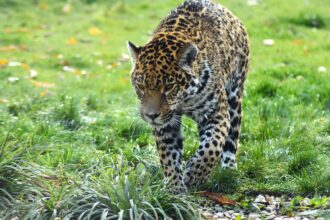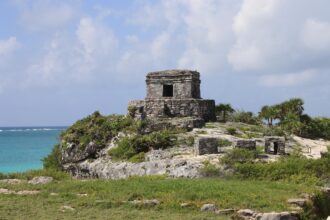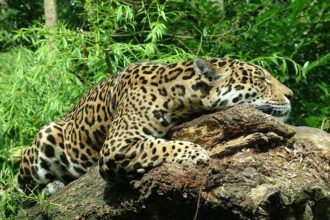Unveiling the Secrets: Jaguar Sightings in Tulum’s Wilderness
The Jaguar: A Majestic Predator
The jaguar (Panthera onca), the largest cat in the Americas, is a symbol of power and stealth. With its powerful physique and striking rosette-patterned coat, this apex predator occupies diverse habitats, from lush rainforests to arid scrublands. In Tulum, a serene coastal town famous for its stunning beaches and ancient ruins, jaguars roam the nearby jungles, making it an intriguing destination for wildlife enthusiasts and researchers alike.
The Habitat of Tulum’s Jaguars
Tulum is bordered by the Sian Ka’an Biosphere Reserve and the Tulum National Park, two critical ecosystems for wildlife. Sian Ka’an, a UNESCO World Heritage Site, hosts diverse flora and fauna, making it an ideal setting for jaguars. The reserve features tropical wetlands, mangroves, and vast expanses of rainforests, providing jaguars with ample cover and food sources. The forests are home to a variety of prey, including peccaries, capybaras, and deer, which play a crucial role in sustaining the jaguar population in the region.
Sightings: Patterns and Locations
Jaguar sightings in Tulum are relatively sporadic due to the species’ elusive nature, but several areas have gained notoriety among wildlife watchers. One of the most promising spots is the edge of the Sian Ka’an Biosphere Reserve, where dedicated wildlife tours often report jaguar sightings. Local guides with extensive knowledge of the area and its inhabitants lead tours that increase the chances of encountering these magnificent felines.
Another prime location is the Tulum National Park, which boasts varied habitats. Exploring the park at dawn or dusk provides an excellent opportunity to spot jaguars. The dense undergrowth and sound of rustling leaves often betray the presence of these majestic cats. Tourists are advised to remain quiet and patient, as jaguars are known for their stealth.
The Best Time for Jaguar Tours
The best time for jaguar tours in Tulum coincides with the wet season, from late May to October. During these months, water levels rise, concentrating prey species near water sources and making jaguars more likely to venture out for hunting. Wildlife photographers and enthusiasts flock to Tulum during this period, often sharing their invaluable experiences on social media platforms, contributing to the growing interest in jaguar conservation in the region.
Conservation Efforts and Challenges
Conservation efforts in Tulum focus on preserving the natural habitat of the jaguar and its prey. Local NGOs and government initiatives work to protect the ecosystems within the Sian Ka’an Biosphere Reserve, mitigating challenges such as deforestation, illegal hunting, and habitat fragmentation. Additionally, ecotourism plays a pivotal role in funding these conservation projects and raising awareness about the urgent need to protect these magnificent creatures.
Despite these efforts, jaguars face significant threats. Urban expansion and agricultural development encroach on their habitat, leading to increased human-wildlife conflict. Mitigating these threats requires community engagement and education to foster coexistence between humans and wildlife.
Understanding Jaguar Habits and Behaviors
Jaguars are solitary creatures, primarily active at night (nocturnal) and at dawn or dusk (crepuscular). This behavior aids them in hunting, allowing them to capitalize on the cover of darkness. Their agility and strength enable them to stalk and ambush prey effectively. Jaguars possess a unique hunting style; unlike other big cats, they deliver a powerful bite through the skull or shell of their prey, ensuring a swift kill.
Understanding these traits helps researchers track jaguar movements and behaviors within their habitat. GPS collaring initiatives have been employed in regions surrounding Tulum, enabling scientists to gather data on jaguar activity patterns, territory sizes, and interactions with other wildlife.
Community and Ecosystem Balance
The local Mayan community plays an essential role in conservation efforts, recognizing the importance of maintaining healthy ecosystems for their livelihood. Sustainable tourism initiatives empower local populations to engage in jaguar conservation while benefiting economically from eco-friendly practices. Community-led programs, such as educational workshops and nature tours, help promote awareness of the challenges facing jaguars and the importance of preserving their habitats.
The Role of Technology in Conservation
Advancements in technology significantly enhance jaguar conservation efforts in Tulum and surrounding areas. Camera traps equipped with motion sensors capture stunning images of jaguars in their natural habitat, providing valuable insights into their behavior and population distribution. These non-invasive tools are instrumental in monitoring jaguar health and demographics without disrupting their habitats.
Additionally, satellite imagery helps researchers identify changes in land use and habitat fragmentation, guiding conservation strategies. By combining traditional ecological knowledge with modern technology, the fight to protect the jaguar in Tulum’s wilderness becomes more informed and effective.
Ethical Wildlife Watching
Engaging in wildlife watching demands a commitment to ethical practices. Visitors are encouraged to employ reputable tour operators who prioritize safety and conservation. Maintaining a respectful distance from wildlife ensures minimal stress on the animals. Furthermore, ensuring that tours adhere to strict guidelines protects the delicate ecosystems that support jaguars and other wildlife.
Insights from Wildlife Experts
Conservationists and wildlife biologists frequently visit Tulum to study jaguar populations. Their experiences and findings emphasize the need for ongoing research and monitoring efforts to gain a better understanding of jaguar behavior and ecology. Workshops held by these experts contribute significantly to local conservation and ecotourism efforts, fostering a greater appreciation for the region’s natural heritage.
Jaguars Beyond Tulum
While Tulum provides a unique ecosystem for jaguars, these majestic creatures inhabit a broader range of ecosystems in Central and South America. From the Amazon rainforest to the Pantanal wetlands, jaguars play an essential role in maintaining ecological balance. Understanding their behavior and habitats beyond Tulum enriches our knowledge of jaguar conservation and underscores the global importance of preserving these magnificent animals.
The Future of Jaguars in Tulum
As environmental awareness grows, the future of jaguars in Tulum relies heavily on sustainable practices that benefit both wildlife and local communities. The delicate balance of tourism, conservation, and environmental education will determine the fate of these creatures in Tulum’s wilderness. As jaguar tourism continues to gain popularity, raising awareness about their ecological significance and the challenges they face is more crucial than ever. With dedicated efforts, Tulum can serve as a model for successful wildlife conservation and a sanctuary for one of nature’s most awe-inspiring predators.







